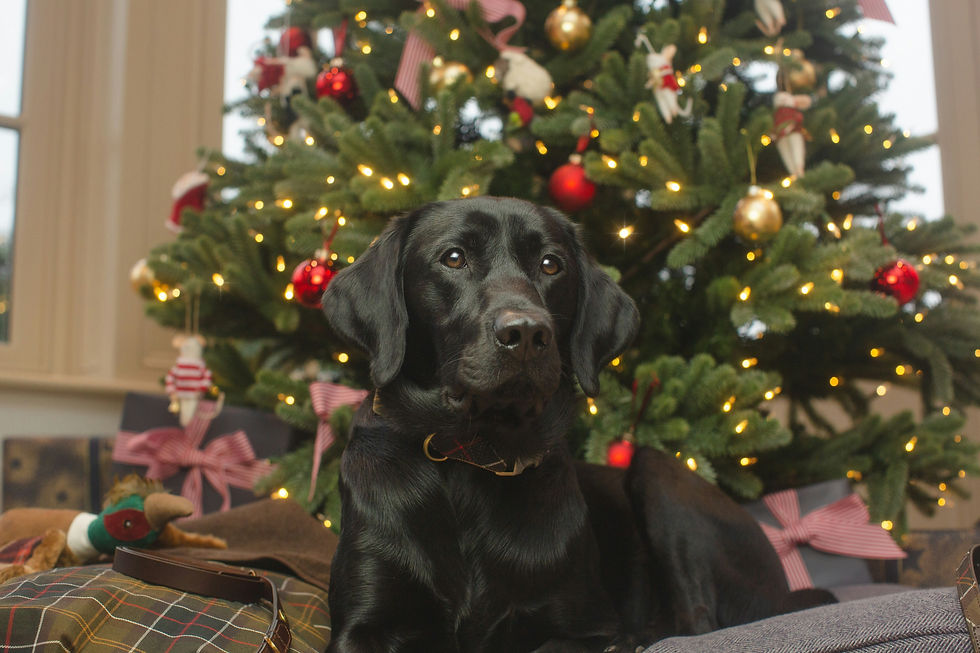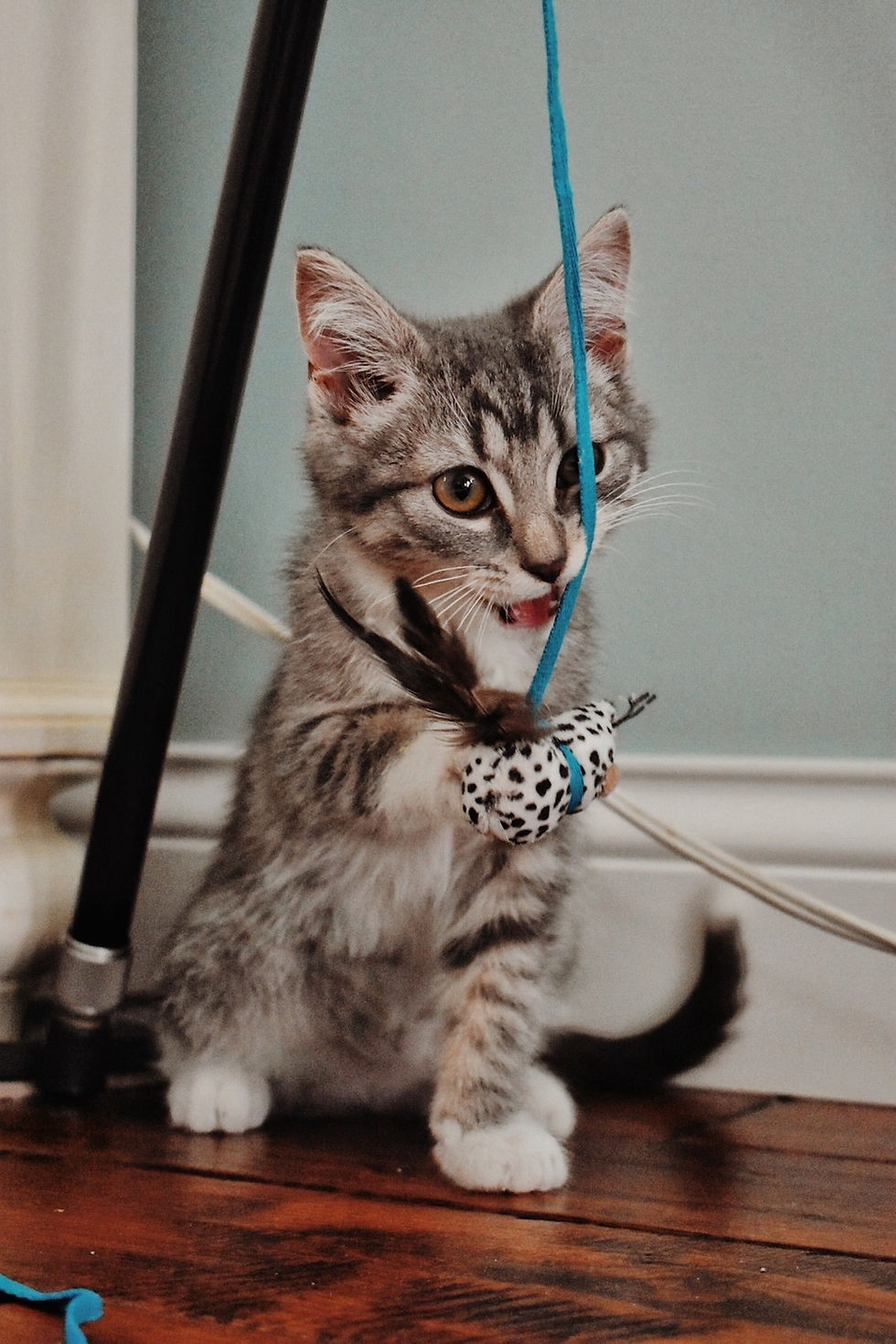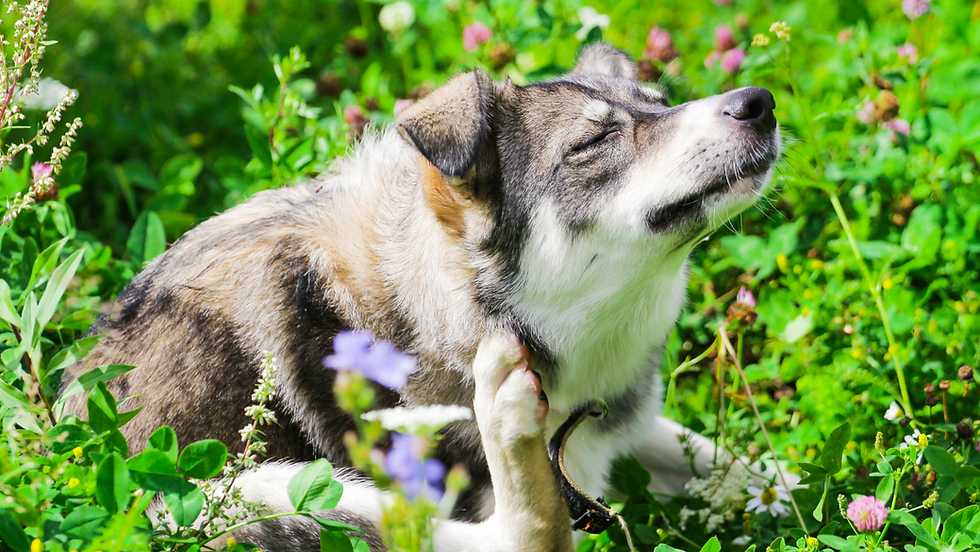Guarding Furry Friends: Navigating the Risks of Toxic Holiday Plants for Pets
- stephanie pope
- Nov 13, 2023
- 14 min read
Updated: May 20, 2025

As we eagerly welcome the holiday season, our homes transform into havens of warmth and merriment adorned with festive decorations. Glittering lights, fragrant greenery, and vibrant colors become an integral part of our surroundings, symbolizing the joy and celebration that accompany this special time of year.
While we revel in the holiday spirit, it's crucial to recognize the potential hazards that our beloved pets may encounter. The hustle and bustle of holiday preparations often bring unfamiliar elements into our homes, and some of these can pose risks to the well-being of our furry friends. This blog aims to shed light on the importance of safeguarding our pets during the holidays, ensuring they can partake in the festive cheer without compromising their health and happiness.
The purpose of this blog extends beyond the tinsel and twinkling lights. We are on a mission to cultivate awareness about the often-overlooked dangers lurking within our holiday decor—specifically, the toxicity of certain plants to our pets. By exploring common holiday plants that can be harmful to our four-legged companions, we hope to empower pet owners with the knowledge needed to create a safe and joyful environment for both humans and their furry family members. Join us on this journey to celebrate the holidays responsibly, with the well-being of our pets at the forefront of our festivities.
Common Toxic Holiday Plants

As the holiday season casts its enchanting spell upon us, our homes become adorned with festive foliage, transforming ordinary spaces into winter wonderlands. However, amidst the twinkling lights and seasonal splendor, there exists a hidden danger that pet owners must be acutely aware of: toxic holiday plants. These seemingly innocent additions to our decor can harbor potential risks for our furry companions. In this section, we delve into the captivating yet perilous world of common toxic holiday plants, unraveling the mysteries behind popular greenery like poinsettias and mistletoe. Understanding the botanical hazards that lurk within our festive displays is not only a matter of safeguarding our pets but also a crucial step toward ensuring a holiday season that is both joyful and safe for every member of the family.
Poinsettias: A Seasonal Staple

The vibrant red and green foliage of poinsettias has made them a quintessential symbol of the holiday season. Adorning homes and festive arrangements, these plants add a touch of seasonal splendor to our surroundings. However, beneath their festive allure lies a potential threat to our furry companions.
Poinsettias contain a milky, white sap that harbors compounds known as diterpenoid euphorbol esters. While ingestion of these components is typically not fatal, they can lead to mild to moderate symptoms in pets. Common effects include gastrointestinal distress, such as vomiting and drooling, and skin irritation if the sap comes into contact with the skin. It's crucial for pet owners to be aware of these potential risks and take proactive measures to prevent pets from nibbling on this holiday favorite. Understanding the toxic components of poinsettias equips us to create a safer environment for our pets during the festive season.
Mistletoe: A Closer Look at the Holiday Tradition
Mistletoe, with its characteristic clusters of greenery and white berries, holds a longstanding place in holiday traditions. There are two primary types of mistletoe that commonly find their way into homes:

European Mistletoe (Viscum album): Recognized by its oval-shaped leaves and white berries, this variety is often used in holiday decorations.
American Mistletoe (Phoradendron spp.): Distinguished by its leathery green leaves and white berries, it is native to North America and frequently used in festive arrangements.
Despite its festive allure, mistletoe poses a significant threat to our furry friends when ingested. The plant contains compounds, such as viscotoxin and phoratoxin, which can lead to a range of adverse effects in pets. The severity of symptoms depends on the type of mistletoe, the amount ingested, and the size of the pet. Potential risks include:
Gastrointestinal Distress: Ingesting mistletoe can result in stomach upset, vomiting, and diarrhea.
Cardiovascular Effects: Some types of mistletoe can affect the heart, leading to irregular heartbeats or, in severe cases, cardiac arrest.
Central Nervous System Impact: Neurological symptoms, such as difficulty breathing and seizures, may occur.
As mistletoe is often used in holiday decorations, pet owners must be vigilant in preventing their animals from accessing this potentially hazardous plant. Understanding the risks associated with mistletoe ingestion underscores the importance of taking precautions to ensure a safe and joyful holiday season for both pets and their human companions.
Holly: Unveiling the Enigmatic Foliage of the Holidays
Holly, with its glossy green leaves and vibrant red berries, stands as an iconic symbol of the holiday season. While there are numerous species of holly, two varieties often find their way into festive decorations.

English Holly (Ilex aquifolium): Recognized by its spiky, deep green leaves and bright red berries, English holly is a popular choice for holiday arrangements.
American Holly (Ilex opaca): Similar in appearance to its English counterpart, American holly boasts dark green foliage and striking red berries, making it a sought-after festive embellishment.
Beneath the beauty of holly lies a potential hazard for our furry friends. Holly plants contain substances such as saponins and methylxanthines, which, when ingested by pets, can lead to adverse effects. The toxic components in holly can result in symptoms such as:
Gastrointestinal Distress: Ingestion may cause symptoms like vomiting, diarrhea, and abdominal discomfort.
Drooling and Pawing: Contact with the leaves can lead to irritation of the mouth and skin, causing excessive drooling and discomfort.
Cardiac Issues: In some cases, holly toxicity may affect the heart, leading to irregular heartbeats.
As holly is often utilized in wreaths, garlands, and other holiday arrangements, pet owners are urged to exercise caution and prevent their animals from accessing these potentially harmful decorations. By understanding the toxic substances in holly, we can take proactive measures to ensure a festive atmosphere that is safe for both humans and their cherished pets.
Christmas Trees and Decorations: Navigating Pine Risks
Pine Needles

As we usher in the holiday season with the timeless tradition of adorning our homes with evergreen trees, the enchanting allure of pine can also pose risks to our furry companions. Pine needles, though seemingly innocuous, can present a hazard when ingested by pets. The sharp, needle-like structure of pine needles can cause irritation and potential blockages in the digestive tract, leading to symptoms such as vomiting, lethargy, and abdominal discomfort. Pet owners are urged to be vigilant in preventing pets from nibbling on fallen needles, ensuring a safer festive environment for their four-legged family members.
Sap and Oils
Beyond the needles, pine trees secrete sap and oils that, while integral to the tree's essence, can be problematic for pets. Ingesting or coming into contact with pine sap can result in skin irritation, digestive upset, and discomfort. Additionally, the aromatic oils found in some pine species may cause respiratory issues in pets. Taking proactive measures to secure the tree and promptly cleaning up fallen needles can significantly reduce the risks associated with pine sap and oils, allowing both humans and pets to bask in the holiday spirit without compromising well-being.
Electrical Dangers for Pets
The soft glow of decorative lights is a hallmark of the holiday season, creating a magical ambiance in our homes. However, amid the enchantment, pet owners must be cognizant of the electrical dangers posed by these dazzling displays. The cords and plugs powering festive lights can be tempting targets for curious pets, posing a risk of electrical shock if chewed or tampered with. Understanding the potential hazards associated with electrical components is paramount for pet safety, prompting the need for proactive measures to mitigate these risks and ensure a hazard-free holiday atmosphere.
Chewed Wires and the Potential for Electric Shock

The allure of twinkling lights may entice pets to explore and, unfortunately, chew on the cords. This seemingly innocent act can have severe consequences, as chewed wires expose pets to the risk of electric shock. The electrical current coursing through the wires can cause injury, ranging from burns to more severe complications. Pet owners are strongly encouraged to inspect and secure all electrical cords, employing protective measures such as cord covers or deterrent sprays to dissuade pets from engaging in potentially hazardous behavior. By recognizing the risks associated with chewed wires, pet owners can take proactive steps to safeguard their furry friends, ensuring a festive season that is both joyous and secure.
Lilies and the Grave Danger to Cats: A Silent Threat Amidst Holiday Blooms
Among the enchanting array of holiday plants, lilies, particularly those belonging to the Lilium spp., stand as an ominous threat to our feline companions. Notably, the Christmas Lily poses a severe risk, as even small amounts of ingestion can lead to devastating consequences, primarily centered around acute kidney failure.

Types of Toxic Lilies:
Easter Lily (Lilium longiflorum)
Tiger Lily
Asiatic Lily
Day Lily
Risk of Kidney Failure
The toxic components within lilies, even in seemingly minuscule amounts, can trigger acute kidney failure in cats. The kidneys play a crucial role in filtering toxins from the bloodstream, and lily toxicity disrupts this vital function.
Symptoms of Lily Poisoning:Early signs of lily poisoning may include vomiting, lethargy, and a lack of appetite. As the toxicity progresses, it can lead to severe kidney damage, causing symptoms such as increased thirst and urination, dehydration, and ultimately, life-threatening consequences.
Prompt Veterinary Intervention: Immediate veterinary attention is paramount if you suspect your cat has come into contact with any type of lily. Even the smallest exposure warrants a swift response, as delaying treatment increases the risk of irreversible kidney damage.
Preventive Measures
As prevention is the most effective form of protection, cat owners should be vigilant about keeping lilies, including bouquets and potted plants, out of their homes. Educating family members and guests about the dangers of lilies to cats is also crucial.
Lily toxicity is a serious and often fatal threat to cats, making awareness and prevention vital during the holiday season and beyond. The beauty of these flowers masks a perilous reality for our feline friends, underscoring the importance of proactive measures to create a safe environment for all members of the family.
More Toxic Holiday Plants

(Amaryllis spp.): This popular holiday plant contains toxins that can cause vomiting, diarrhea, abdominal pain, and even tremors in pets.
Christmas Rose (Helleborus spp.): Also known as Hellebores, these plants contain compounds that can be toxic to pets and cause symptoms such as gastrointestinal upset and depression.
Christmas Cherry (Solanum pseudocapsicum): The berries of this plant can be toxic to pets if ingested, leading to symptoms like gastrointestinal distress and lethargy.
Jerusalem Cherry (Solanum pseudocapsicum): Similar to Christmas Cherry, this plant contains toxic berries that can be harmful to pets.
Christmas Kalanchoe (Kalanchoe blossfeldiana): This flowering plant can cause vomiting, diarrhea, and other gastrointestinal issues in pets when ingested.
Always be cautious and research any plants you plan to bring into your home during the holidays to ensure they are safe for your pets. If you suspect your pet has ingested a toxic plant, contact your veterinarian or an emergency animal poison control hotline immediately.
Safe Alternatives and Precautions: Crafting a Pet-Friendly Festive Haven
Pet-Friendly Plants
While the charm of traditional holiday plants like poinsettias, mistletoe, and holly is undeniable, pet owners can still infuse their homes with festive greenery without compromising their furry friends' well-being. Opting for non-toxic alternatives such as spider plants, Christmas cacti, or Boston ferns allows pet owners to maintain the holiday spirit while eliminating the risks associated with toxic plants.

Spider Plants (Chlorophytum comosum): Spider plants are known for their arching leaves that are green with white stripes. They often produce offshoots, known as "pups," creating a cascading and visually appealing effect. Pet Safety: Spider plants are non-toxic to cats and dogs, making them a safe alternative to traditional holiday plants. However, while considered safe, ingestion may still cause mild stomach upset in pets.
Christmas Cacti (Schlumbergera): Christmas cacti are succulent plants with flat, segmented stems and vibrant, tubular flowers. They are popular for their blooming during the holiday season. Pet Safety: Christmas cacti are generally non-toxic to cats and dogs, making them a festive and safe choice for pet owners. As with any plant, it's wise to monitor pets to ensure they don't ingest large quantities, which could still lead to mild digestive upset.

Boston Ferns (Nephrolepis exaltata): Boston ferns are lush, feathery ferns with delicate fronds that give them a graceful appearance. They are often used as indoor plants and are known for their air-purifying qualities. Pet Safety: Boston ferns are considered non-toxic to cats and dogs, making them a lovely and safe addition to homes with pets. As with any plant, it's essential to monitor for any signs of curiosity or nibbling, but ingestion of these ferns is generally not harmful.
These plants are popular choices for pet owners because they add a touch of greenery to the home while posing minimal risks to the health of cats and dogs. It's important to note that individual pets may react differently, so it's always wise to observe them when introducing new plants and seek veterinary advice if any concerning symptoms arise.
Tips for Selecting Safe Decorations
Beyond plants, the selection of decorations plays a pivotal role in creating a pet-friendly festive atmosphere. Consider the following tips when choosing decorations:
Avoiding Small, Swallowable Items: Opt for larger, non-swallowable ornaments to minimize the risk of choking or intestinal obstruction in pets.
Sturdy Tree Stands: Ensure your Christmas tree is securely anchored in a sturdy stand to prevent accidental toppling, reducing the risk of injury to both pets and humans.
Tinsel-Free Zones: Keep tinsel out of reach, as its shiny allure may attract pets, posing a choking hazard if ingested.
Secure Electrical Cords: Use cord covers or conceal cords to prevent pets from chewing on electrical decorations, minimizing the risk of electric shock.
By embracing pet-friendly alternatives and adhering to precautions when selecting decorations, pet owners can foster a festive environment that prioritizes the safety and well-being of their four-legged family members. This harmonious blend of holiday cheer and pet safety ensures that everyone, furry and otherwise, can revel in the joy of the season.
Placement and Supervision: Safeguarding Festive Delights and Furry Companions
As we deck the halls with festive greenery and decor, strategic placement plays a pivotal role in ensuring the safety of our pets. Consider locating potentially toxic plants, such as poinsettias and mistletoe, in areas less accessible to curious pets. Elevated surfaces, shelves, or hanging arrangements can help minimize the risk of accidental ingestion. Likewise, arranging decorations, including ornaments and lights, with consideration for pet accessibility can contribute to a hazard-free holiday space. By thoughtfully placing these elements, we create an environment that allows us to revel in the festive spirit while mitigating potential risks to our four-legged family members.
Amidst the holiday hustle and bustle, the importance of vigilant supervision cannot be overstated. Keeping a watchful eye on our pets ensures a swift response to any signs of curiosity or attempts to explore festive decorations. Regularly check on them to prevent nibbling on plants, chewing on electrical cords, or engaging in other potentially hazardous behavior. This hands-on approach allows us to address any emerging risks promptly. Whether it's a playful paw reaching for ornaments or a curious nose near a festive plant, proactive supervision is key to fostering a secure and enjoyable holiday environment for both pets and their human companions. By combining strategic placement with attentive supervision, we can strike a harmonious balance, ensuring that the festive season remains a time of joy, peace, and safety for all.
Signs of Poisoning in Pets: Decoding the Language of Distress
This dedicated section serves as a guide to understanding the signs of distress in pets, offering insights into the subtle cues and overt signals that may indicate their well-being is compromised. From common symptoms of plant poisoning to neurological manifestations, we unravel the mysteries behind these signs, empowering you to act with precision and care. As we celebrate the season of joy, let us also celebrate the bond we share with our pets by fostering an environment that ensures their safety and comfort. In the symphony of holiday cheer, let this section be your guide to preserving the harmony of health for your four-legged family members.
Common Symptoms of Plant Poisoning

Gastrointestinal Distress: One of the initial indicators of plant poisoning in pets manifests in gastrointestinal distress. Watch for symptoms such as vomiting, diarrhea, and excessive drooling. These signs often signal that a pet has ingested a substance that their system finds irritating or toxic. Prompt attention to these symptoms is crucial to prevent further complications and discomfort.
Neurological Symptoms: In cases of plant poisoning, neurological symptoms may also surface. These can range from disorientation and confusion to more severe manifestations like seizures or tremors. Observing any abnormal behavior, unsteady movements, or signs of altered consciousness should raise immediate concern and warrant prompt veterinary evaluation.
When to Seek Veterinary Assistance: Recognizing the urgency of seeking veterinary assistance is paramount in ensuring the well-being of our pets. If you observe any of the aforementioned symptoms or notice abnormal behavior, do not hesitate to contact your veterinarian. Quick action is particularly crucial if there's a known or suspected ingestion of a toxic plant. Timely intervention can make a significant difference in the outcome, as some plant toxins can lead to rapid deterioration in a pet's health. Don't rely on home remedies; instead, consult with a veterinary professional who can provide tailored advice and appropriate treatment to address the specific poisoning issue.
Understanding these signs equips pet owners with the knowledge needed to respond promptly in case of plant poisoning. By staying vigilant and acting swiftly, we can safeguard the health and well-being of our furry companions during the holiday season and beyond.
Emergency Actions: Safeguarding Pets in Crisis
In the hustle and bustle of the holiday season, unexpected emergencies can cast a shadow over the festive cheer, especially when it comes to the well-being of our beloved pets. This dedicated section serves as a beacon of guidance, offering insights into crucial emergency actions and responses in the unfortunate event of a crisis. From toxic plant ingestions to unforeseen accidents, we delve into the steps every pet owner should be familiar with when seconds count. Here, we equip you with knowledge to navigate emergencies with composure, ensuring the safety and swift recovery of your furry companions. In the face of uncertainty, preparation becomes our greatest ally, and by understanding these emergency protocols, you can approach any situation with the confidence needed to protect the health and happiness of your pets
Steps to Take if a Pet Ingests a Toxic Plant

Contacting a Veterinarian: In the event that a pet has ingested a toxic plant, immediate communication with a veterinarian is paramount. Dial your veterinary clinic or emergency animal poison control hotline without delay. Provide essential details, such as the type of plant ingested, the quantity if known, and the observed symptoms. A veterinarian can offer guidance tailored to the specific situation, enabling swift and effective action.
Inducing Vomiting (If Recommended by a Professional): While inducing vomiting is not always the recommended course of action and should only be done under professional guidance, it can be a crucial step in certain cases. Veterinarians may recommend inducing vomiting to expel the ingested substance before it is fully absorbed into the bloodstream. However, this procedure is highly situation-specific and must be carried out under veterinary supervision to avoid potential complications. Never attempt to induce vomiting without consulting a professional, as it may be contraindicated depending on the toxin involved or the time elapsed since ingestion.
In times of crisis, swift and informed action is the key to mitigating the impact of toxic plant ingestion. By contacting a veterinarian promptly and following their guidance, pet owners can significantly improve the chances of a positive outcome. Remember, a veterinarian is the most reliable source for advice and intervention in cases of plant poisoning, and their expertise ensures the well-being of our beloved pets during emergencies.
Conclusion: Cherishing a Safe and Merry Holiday Season with Our Furry Companions
As we immerse ourselves in the magic of the holiday season, it is crucial to reflect on the significance of safeguarding the well-being of our cherished pets. From festive plants to dazzling decorations, the elements that bring joy to our homes can inadvertently pose risks to our furry companions. By understanding and mitigating these hazards, we ensure that the season remains one of celebration and warmth for both humans and their four-legged family members.
Knowledge is a powerful tool, and as responsible pet owners, we have the ability to make a collective impact. Let us take a moment to share the insights gained about toxic holiday plants and safety measures with our fellow pet enthusiasts. Whether through conversations, social media, or community forums, spreading awareness empowers others to create safe havens for their pets during the festivities. Together, we can build a community committed to the well-being of our furry friends.
In closing, as we navigate the enchanting landscapes of the holiday season, let's prioritize the safety and happiness of our pets. May the warmth of togetherness, the glow of festive lights, and the joy of shared moments define this season for all of us—two-legged and four-legged alike. Wishing everyone a safe and joyful holiday season filled with love, laughter, and the unmistakable delight of celebrating in the company of our beloved pets. Here's to a season of harmony and happiness for the entire family, furry friends included.




